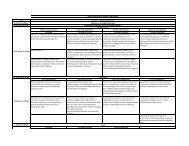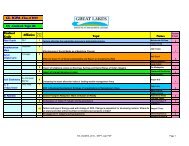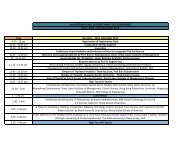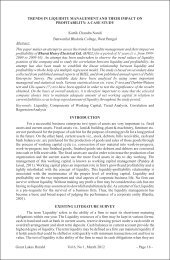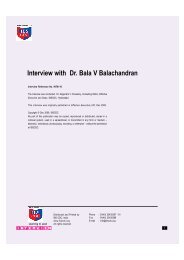Comparative Analysis of Indian Stock Market with ... - Great Lakes
Comparative Analysis of Indian Stock Market with ... - Great Lakes
Comparative Analysis of Indian Stock Market with ... - Great Lakes
You also want an ePaper? Increase the reach of your titles
YUMPU automatically turns print PDFs into web optimized ePapers that Google loves.
Circuit Breakers<br />
54<br />
The KSE introduced the Circuit Breakers in December 1998. In order to pacify the over-<br />
reaction <strong>of</strong> investors, when the stock price drops suddenly below certain level (more than 10%<br />
<strong>of</strong> the closing price <strong>of</strong> the previous day and such situation continues for longer than one<br />
minute), the circuit breakers system was introduced on December 7, 1998. The trading, which<br />
resumes by periodic call auction where the orders submitted during the first 10 minutes after<br />
the trading halt ended, are matched at a single price.<br />
Regulation on program trading<br />
As a measure used to minimize possible impacts <strong>of</strong> futures market on cash market, thus<br />
maintaining the stability <strong>of</strong> the cash market, when the price <strong>of</strong> the most active futures<br />
contract continues to change 5 % or more than the base price for one minute, execution <strong>of</strong> all<br />
program trading orders in the cash market is delayed for 5 minutes.<br />
Trading Halt<br />
In order to protect investors, when, due to rumors or reports on the matters (e.g., bank<br />
defaults, bankruptcy, corporate restructure, etc.) that have major implication on corporate<br />
management, sudden and drastic change <strong>of</strong> trading value and volume is anticipated, the<br />
trading <strong>of</strong> such issues may be halted. In such a case, the concerned corporation is asked to<br />
make an inquiry into such rumors or reports and disclose findings.<br />
Hong Kong <strong>Stock</strong> Exchange<br />
Though a circuit-breaker has not been adopted yet, a two-tier circuit-breaker is being<br />
considered, under which trading would stop for half an hour in the event <strong>of</strong> a 15% fluctuation<br />
over the previous day’s close, and for one hour in the event <strong>of</strong> a 25% fluctuation. Another<br />
option being considered is an individual circuit-breaker per stock, which would cause a ten-<br />
minute open-outcry auction to be initiated every time a stock price varied more than 10% over<br />
last day’s close.<br />
Trading and Settlement Cycle<br />
This segment takes care <strong>of</strong> the efficiency issue <strong>of</strong> the said stock exchange. It basically looks<br />
into the speed at which any <strong>of</strong> the numerous transactions affected in the market gets settled.<br />
This is especially crucial given the volume. We see that <strong>Indian</strong> exchanges are at par <strong>with</strong> the<br />
best in the world when it comes to efficient settlement. It can even go one up if the proposed<br />
‘T+1’system is put in place.<br />
©<strong>Great</strong> <strong>Lakes</strong> Herald – April 2007 Volume 1, Issue 1 by <strong>Great</strong> <strong>Lakes</strong> Institute <strong>of</strong> Management, Chennai






